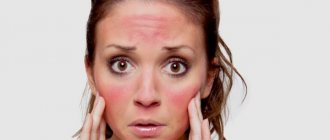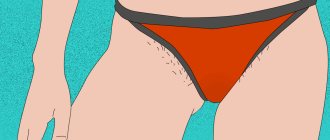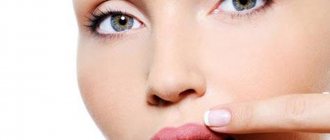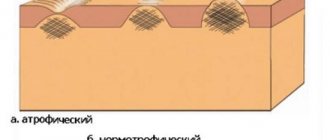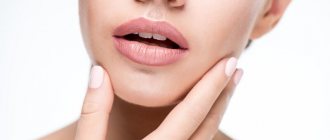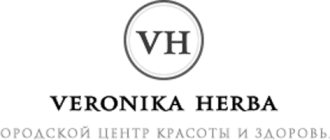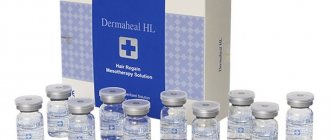Burns after laser hair removal are a possible undesirable effect of hardware hair removal. Injuries are caused by insufficient cooling of the skin or unprofessionalism of the cosmetologist. The procedure involves the destruction of hair follicles with laser beams with a wavelength in the range of 690-800 nm. They are absorbed by the pigment melanin, which is found in hair and skin. Thermal energy destroys the cells of the basal layer of the dermis and the superficial capillaries that nourish the hair follicles. Prolonged contact with laser radiation can cause burns to adjacent tissues.
How does a laser act on the skin: causes of burns
Laser hair removal is the removal of body hair using laser radiation with high energy density. Light exposure to the skin leads to the destruction of follicles and hair root loss. The main causes of thermal burns during the procedure include:
- improper training of a cosmetologist;
- visiting a solarium before the procedure;
- hypersensitivity of the skin;
- laser epilator malfunction.
In 90% of cases, people with dark skin get burns. Due to the increased concentration of melanin, tissues absorb more thermal energy, which provokes thermal injuries.
Causes
Most often, pigment spots appear due to disruption of the cells that produce the dark pigment – melanin. Such failures may occur under the influence of the following factors:
- infectious diseases;
- taking certain medications;
- use of formulations containing photosensitizers;
- traumatic effects on the dermis;
- frequent and severe overheating.
Burns and darkening of the skin may occur if there are contraindications, non-compliance with the rules for preparing for hair removal and incorrectly selected device settings.
Therefore, before carrying out the procedure, you should definitely tell the dermatologist about existing diseases, allergies to drugs, and treatment.
Selecting the type of laser for your skin type
The choice of laser radiation source depends on the type of skin. To destroy follicles during hair removal, lasers with different wavelengths of light are used:
- neodymium - solid-state emitter with a wavelength of 1060 nm, suitable for people with dark or tanned skin;
- diode – laser emitter with a wavelength of 800 nm, which is suitable for all types of skin;
- alexandrite - a fast-penetrating laser with a wavelength of 700 nm, intended for people with red hair;
- ruby – a laser radiation generator with a working wavelength of 695 nm, which is used to remove light hair from dark skin.
The procedure time depends on the density of the laser beam and the degree of hair growth of the skin.
Depilation should take place in a salon, under the strict guidance of experienced professionals.
The correct choice of light generator prevents unnecessary heating of tissues and damage to the skin.
Folk recipes
First-degree burns can be treated at home using traditional recipes, but you must first consult a dermatologist. After his consultation and advice regarding traditional methods, you can choose the most suitable and effective methods.
Calendula ointment
Calendula ointment can be purchased at a pharmacy, or you can prepare it yourself, and its medicinal properties will not be inferior to pharmaceutical preparations. You need to take 1 spoon of calendula tincture with alcohol, mix it with 2 tablespoons of Vaseline, or you can replace Vaseline with glycerin.
All ingredients must be mixed and left for several hours. The resulting ointment should be applied to damaged skin 4 times a day, for about 5-6 days.
St. John's wort oil
St. John's wort oil has excellent healing properties. It relieves inflammation, disinfects damaged areas, relieves pain and promotes tissue healing. The oil can be prepared at home; for this, calendula flowers are filled with any vegetable oil, approximately 200 grams of oil per 60 grams of flowers. The oil should sit for a day to obtain all the beneficial properties of calendula.
Compresses are made from the oil and applied to the burn. The gauze must be soaked in oil and secured to the damaged area with a bandage or plaster. The gauze needs to be changed after 6 hours.
Cabbage leaf bandage
In order to relieve inflammation and soothe burned skin, you can use a compress of cabbage leaves. To do this, a leaf of fresh cabbage must be thoroughly washed with water, scalded with boiling water and crushed with your hands so that the cabbage releases juice. Afterwards, the sheet is applied to the burn site for a couple of hours.
During the day, the cabbage leaf bandage is changed 6 times. This treatment can only be used if the burn is uncomplicated, that is, without blisters and ulcers. 3-4 days is enough to relieve inflammation.
Treatment of burns after laser hair removal (video):
Signs of a burn after laser hair removal
Burns after laser hair removal look different. The symptomatic picture depends on:
- intensity of light radiation;
- degree of tissue sensitivity;
- duration of laser radiation.
Most often, injuries occur when treating the skin in the bikini area and under the arms. In these areas, the protective layer of the epidermis is thin, making it vulnerable to heat damage. A burn from laser hair removal is indicated by:
- redness;
- swelling;
- itching;
- burning;
- peeling;
- blisters;
- crusts in the lesion.
In 80% of cases, after hardware hair removal, shallow burns of 1st and 2nd degrees are obtained. First, the tissues swell and acquire a reddish tint. When the keratinized epithelium and basal layer of the dermis are damaged, bubbles with transparent contents form. Since the sensory receptors remain unaffected, patients complain of burning or pain.
Improper first aid increases the risk of infectious inflammation. When pyogenic bacteria penetrate the wound, the condition of the tissue worsens. Ulcers form, from which a light green or yellow exudate with a putrefactive odor is released. Infectious inflammation prevents scarring of the skin and provokes complications in the form of trophic ulcers and fistulas.
Benefits and effectiveness of the procedure
Photoepilation is one of the methods of hair removal, that is, the removal of hairs from the bulb. The principle of the method is the impact of a specially focused beam of light on the hair, which allows you to safely, painlessly and contactlessly remove hair over a large area of the body.
Light is absorbed by melanin contained in the hair shaft. As a result of heating the rod, the cells that are responsible for hair growth are destroyed. The follicle is destroyed completely and irrevocably - hair will no longer be able to grow in this place.
Unlike others, this hair removal method has a number of advantages:
- the speed of the procedure - for example, it takes only 15 seconds to remove hair from the upper lip, during which three flashes of light are produced. In general, the procedure on any part of the body takes from 5 to 20 minutes;
- versatility - photoepilation, unlike laser hair removal, can be used by people with any skin and hair color (except gray and white), it can be performed on any part of the body;
- accompanying processes in the form of skin regeneration and rejuvenation, production of elastin and collagen;
- integrity of the skin – during the procedure the device does not come into contact with the skin, the light beam may damage it slightly;
- complete removal of hair in six to eight sessions at intervals of two weeks to one and a half months;
- duration of the effect - after the first procedure, you can forget about your hair for five months, subsequently it will grow thinner and sparser.
Did you know?
Radiation during photoepilation is similar in structure to sunlight, but without ultraviolet radiation. Intense Pulsed Light (IPL) was first used to destroy hair in 1997.
First aid
A burn after laser hair removal requires immediate treatment of the damaged tissue. First aid involves the following measures:
- Cooling. To stop the heat exposure and prevent further destruction of soft tissue, you need to place the affected area under running water for 10-15 minutes. Alternatives include an ice bag, cold compress, and hypothermic pack. But you should not use them for more than 10 minutes to avoid frostbite.
- Anesthesia. In case of severe pain, the victim is given non-narcotic analgesics - Piroxicam, Ketoprofen, Amidopyrine. To enhance their effect, take 1-2 Spazmalgon tablets.
- Treatment with anti-burn agents. The area of redness is lubricated with ointments with anti-inflammatory and antiseptic effects - Rescuer, Furacilin, Sintomycin. If the epidermis is hypersensitive to drugs, the skin is treated with Panthenol or Dexpanthenol spray. The foam is evenly applied to the affected area, covering 2 cm of healthy tissue around the burn.
- Applying a bandage. Blistering rashes on the burned area are covered with a sterile bandage. The skin is pre-treated with antiseptic ointments - Betadine, Dioxidin, Miramistin, etc. They prevent the penetration of infection and the transformation of the transparent exudate of the vesicles into pus.
If you are burned by laser radiation, you should not treat the affected areas with folk remedies - egg whites with flour, alcohol tinctures, badger fat, vegetable oils, etc. Self-medication is fraught with an increase in the area of the burn and infectious complications. For superficial burns, further treatment is continued at home.
Treatment at home
You can take care of damaged skin areas at home, but do this only using safe methods. Within 5 days after receiving a burn, you need to treat the area with Panthenol ointment. Apply the ointment carefully until completely absorbed 2 times a day. After application, you need to wait 20-25 minutes until it is completely absorbed.
After the burn goes away, the skin in this area will be dry; it needs to be nourished and moisturized with special creams. This must be done until it recovers again; elastic and soft skin without peeling can be considered an improvement.
But creams should be moisturizing, and not greasy, which can create a film on the damaged area, interfering with its healing and oxygenation. Therefore, oils and lotions for moisturizing the skin after a burn are prohibited.
- Blisters, if they form, cannot be punctured, as they will heal more slowly and can provoke tissue infection.
- Treatment of burns must be gradual and correct, so that after healing there are no scars left on the skin.
Treatment and skin care after a burn
For relatively shallow burns, only local therapy with antiseptic, analgesic, and wound-healing drugs is carried out. The duration of treatment varies from 3 to 14 days.
If the skin is damaged along with a mole after hair removal, you should consult a doctor to rule out malignancy.
At the initial stage, the following ointments and gels are used:
- Amprovisol is an analgesic and anti-inflammatory drug that has a cooling effect. Prescribed for thermal burns of 1st and 2nd degree. The aerosol is sprayed onto cleansed skin 1-3 times a day.
- Argakol is a gel with glycerol and dioxidine, which has a disinfecting, analgesic and wound-healing effect. Prevents the formation of blisters, protects burn wounds from infections. Apply a thin layer to laser burns 2-3 times a day.
- Dettol Benzalkonium Chloride is a disinfectant solution with anti-inflammatory properties. Intended for the treatment of laser burns complicated by purulent inflammation. The wound is washed 2-4 times a day for a week.
Treatment of laser burns at home is carried out with wound healing ointments. They are used after opening the vesicles to quickly restore the integrity of the epidermis. The most effective pharmaceutical products include:
- Lioxazine is a napkin made of non-woven material with hydrogel impregnation. It has a bactericidal and regenerating effect on burned tissues. Apply to damaged tissues for 30 minutes up to 3 times a day.
- Dexpanthenol is a wound-healing ointment with provitamin B5, which accelerates metabolism in the skin. Accelerates the healing of burns, stimulates local immunity.
- Aekol is a vitamin solution that exhibits antioxidant, wound healing and anti-inflammatory effects. Heals thermal burns and trophic ulcers after laser exposure.
- Algofin is an antimicrobial ointment with a wound-healing effect. Used in combination therapy of burns caused by laser and radiation.
To treat bacterial inflammation of the skin and prevent purulent complications, drugs with antimicrobial action are prescribed:
- Altargo is an antibacterial ointment that prevents purulent inflammation of burns. Apply to damaged areas twice a day for 5 days.
- Dioxidin is a broad-spectrum antibiotic intended for the prevention and treatment of purulent complications. The ointment is used to treat burns once a day for 2 weeks.
- Silvederm is an antimicrobial ointment that accelerates the healing of 1st and 2nd degree burn wounds. Apply to cleansed skin under a bandage 2 times a day.
There are many sebaceous and sweat glands concentrated in the armpits and groin area. Therefore, burns in these areas are often accompanied by infectious inflammation. For abscesses and abscesses, patients are prescribed systemic antibacterial therapy with drugs from the group of cephalosporins, fluoroquinolones - Ceftriaxone, Cefazolin, Pefloxacin.
Types of burns
A 1st degree burn is the mildest and is characterized by redness of the skin and slight swelling. Burn spots can have different sizes and different shapes.
The crust that appears at the burn site develops into a 2nd degree burn. This degree is characterized by the appearance of blisters, the skin in the injured areas hurts, itches and can develop into infectious diseases of the epidermis.
If symptoms appear, you should immediately contact a dermatologist or cosmetologist, who will advise you on the necessary treatment and skin care. Each degree of burn requires special and individual treatment, which is impossible to choose on your own.
What not to do after the procedure
After hair removal, you need to follow the rules for caring for damaged skin. Ignoring them often causes injuries and complications.
In most cases, cosmetologists advise women to use special restorative creams after laser hair removal.
To avoid unpleasant consequences, you should:
- avoid getting the skin wet for 24 hours after laser treatment;
- stop using hard washcloths for three days;
- avoid exposure to sunlight on the skin;
- refrain from visiting swimming pools and saunas for 1.5-2 weeks;
- Avoid visiting solariums for 14 days.
When removing hair from the facial area, it is not recommended to use scrubs, resort to chemical peeling, or apply self-tanning cream for 10-14 days. You should also refrain from excessive physical activity. For people with excessive skin pigmentation, sunbathing and body massage are contraindicated for a month. Failure to follow the recommendations can result in irritation and superficial burns.
Typically, a laser hair removal course consists of 3-8 sessions. During this period, you need to use regenerating ointments, moisturizing and cooling creams. They restore the hydrolipid mantle of the epidermis. Thanks to this, the skin becomes less sensitive to the effects of laser radiation.
How does the procedure work?
The procedure for hair removal in the bikini area is carried out in several stages. Each implies mandatory compliance with all specialist recommendations.
The body and body must be prepared for the upcoming manipulation
It is important that the client does not use antibiotics or psychotropic drugs a week before the appointed date.
If the patient feels unwell or weak, it is better to postpone the procedure until another day and monitor how he feels. It is strictly forbidden to sunbathe a few days before the appointed date.
The sequence of actions depends on the type of photoepilation prescribed: deep bikini or external hair removal. Many clients prefer to wear a swimsuit during the procedure. This allows you to hide the intimate area and at the same time treat visible areas of the body quite well.
To protect the eyes (both of the patient and the specialist), special glasses are used. They are made of plexiglass, provide a good overview and reliably protect the visual organ.
During a session of epilation of the bikini area, the specialist monitors the reaction of the patient’s skin and body to light radiation. Sometimes a negative reaction forces you to stop the session immediately.
Based on the first procedure, the cosmetologist will determine for the future how many sessions are needed and what power of light pulses to use.
Preparation
The patient must not only monitor his health before visiting the specialist, but also properly prepare for the procedure. Hair in the intimate area must be grown to 1 cm.
You should not use scrubs or cosmetics containing wax before bikini hair removal. Some substances are able to tightly envelop the hair and prevent the penetration of light impulses.
The body must be clean. Do not apply lotions, oils or talc to it. Cosmetics can affect the final result.
The preparatory stage includes diet and rest. The patient is recommended to switch to a more gentle diet and drink enough fluids 3 days before the procedure.
It is important that the body receives adequate sleep and rest.
If you properly prepare the body and organism, a person will tolerate photoepilation well, and no undesirable reaction will occur.
Stages
All actions during hair removal in the bikini area take place in several stages:
- A special cream is applied to the body, which protects the skin from burns and pain. Some cosmetologists use special sprays or gels before and after treatment. These products prevent irritation and help soothe the skin after the procedure.
- The patient and technician put on safety glasses. The cosmetologist works in medical gloves. A special rubber protection is placed on the woman’s abdomen and ovaries.
- The cosmetologist runs a special device over the body. The device transmits flashes of radiation that destroys hairs in the bikini area. The master produces from 30-90 flashes during one session. The type of bikini performed (deep or simple) plays an important role in the strength and frequency of impulses. If the hair is light in color, it is more difficult to get rid of it, so the frequency of flashes and power in this case are increased. If the client is white-skinned and the epidermis is prone to irritation, the power is reduced and the frequency is increased.
- At the end of the work, the cosmetologist cleans the bikini area with special antibacterial wipes and applies a soothing gel to the body. The client receives a number of recommendations regarding further skin care.
The patient should know that for the first 3-4 days after hair removal, it is strictly forbidden to visit natural bodies of water, sunbathe in the sun, or go to the pool, sauna or bathhouse.
Do not use scrubs or hard washcloths while showering. After each session there is a rehabilitation period of 5-10 days
At this time, it is extremely important to follow the recommendations of the cosmetologist.
Possible complications
Laser hair removal devices rarely cause negative consequences. But when depilating the bikini, armpits, groin and other areas with sensitive skin, the following sometimes occur:
- redness;
- perifollicular edema;
- hyperpigmentation;
- photosensitivity;
- folliculitis;
- exacerbation of herpes.
The severity of side effects depends on the density of the laser beam, hair and skin color. Complications are more common in dark-skinned people, since darker skin absorbs more thermal energy. Because of this, not only the hair follicles are destroyed, but also the surrounding tissues.
Why do hanging moles appear?
Hanging moles are a consequence of infection of the body with papillomavirus. Skin formations on a thin stalk are called papillomas. These nevi are easily damaged by awkward movements and touches, so it is better to get rid of them in advance.
After removing the papilloma, the doctor prescribes drug therapy to the patient aimed at destroying the virus. In some cases, hanging moles appear not due to papillomavirus, but due to other factors:
- hormonal fluctuations during puberty or after childbirth;
- ultraviolet radiation;
- hereditary predisposition.
Who is contraindicated for laser hair removal?
Laser hair removal on the body has absolute and relative contraindications. The first category includes:
- decompensated diabetes mellitus;
- squamous cell skin cancer;
- blonde hair;
- low blood clotting;
- leukemia;
- individual intolerance to the procedure.
The procedure is not performed on persons under 18 years of age. Relative contraindications include:
- exacerbation of herpes;
- hypopigmentation;
- fresh tan;
- relapses of allergic dermatosis;
- burns, acne, pimples in the treated area;
- pregnancy;
- multiple moles on the body;
- phlebeurysm.
Ignoring contraindications is fraught with burns, keloid scars, and malignancy of tumors. In patients with excessive sweating and sebum secretion, the risk of inflammation of the hair follicles increases. Folliculitis in people with immunodeficiency is dangerous due to furunculosis.
If you have dark skin, you should not use alexandrite lasers, as they are highly likely to cause deep burns. You should also refrain from hair removal during exacerbation of ENT diseases - laryngitis, bronchitis, sinusitis, etc.
The mechanism of action of a laser beam on hair
Hair growth is affected by many factors, such as gender, weight, age, metabolism, hormonal levels, and even the effects of certain medications. However, hair growth has three stages:
- Anagen is considered the period when hair is actively growing. This period lasts up to 5-6 years. Age significantly affects this stage, since it is with age that the duration of the phase decreases.
- Catagen is the stage when the hair follicle is deprived of nutrition, as a result of which division stops and keratinization occurs. This period lasts on average no more than two to three weeks.
- Telogen is considered the period when the hair and hair follicle come to rest. It is at this stage that mechanical hair removal leads to the very first phase, when the hair begins to grow again.
It is believed that in more than 70% of healthy people, hair is in the very first stage, but even the fact that hair grows back again and again does not stop women on their way to the salon for laser hair removal.
The impact of the light emitted by the laser beam, as well as the flashes from it, penetrate quite deeply, destroying the hair follicles with its heating. Most often, one procedure is not enough to completely get rid of unwanted hair on the body, and over time, hair growth from exposure to a laser beam stops.
Unfortunately, it is impossible to get rid of unwanted hair in one laser hair removal session. On average, in order to destroy unwanted hair and stop its growth in some areas of the body, it will take from 3 to 10 sessions. The number of which must be notified to you before the procedure. The cost of laser hair removal depends both on the pricing policy of the salon that provides such a service, and on the area of the body where the laser beam will be directly used.
https://youtube.com/watch?v=_9YZluYiX9U
Prevention of skin trauma
To avoid burns, you need to follow the rules for preparing the skin for the laser procedure:
- 3-4 days before hair removal, do not use alcohol-containing solutions or ointments;
- do not visit solariums or tan in the sun for 14 days;
- do not remove hair by other means within 20 days;
- do not take tetracycline antibiotics 2 weeks before the procedure.
To achieve the desired effect, it is recommended to shave the epilation area 8 hours before the session. After each procedure, you need to use cooling gels that prevent overheating of the skin and superficial burns. Compliance with the recommendations prevents side effects and complications.
Results
- Modern cosmetic care technologies offer options for removing unwanted hair, regardless of hair growth areas.
- Each person has an individual structure of the hair follicle, hair structure, its chitinous shell, including skin type and color. Much is determined by genetic factors and the functioning of the hormonal system.
- Prices for hair removal services vary. If you do sugaring at home, having prepared the mixture yourself, then the price does not exceed 200-300 rubles per session. The most expensive is electrolysis, since the doctor treats every pore.
- Photoepilation and laser procedures differ in the method of exposure. The beam covers larger areas than light. Their effect is longer lasting.
- Regardless of the method, you need to take into account contraindications and allergies, skin condition, and health. And be sure to consult whether it is possible to do hair removal during menstruation, if these days fall on the date of the session. We also recommend that you familiarize yourself with the Pavia Spa Cosmetics sugaring paste in this material.
Features of male facial hair removal
More recently, facial hair on a man was considered a sign of brutality. However, fashion has changed, and laser facial hair removal for men is becoming an increasingly popular way to get rid of unwanted hair every year. Its most important advantages are the long-term effect and the ability to completely get rid of vegetation after a certain number of procedures.
Men often resort to laser hair removal on their face to:
- straighten the hairline;
- eliminate vegetation in hard-to-reach areas (nose and ears);
- completely remove facial hair in case of irritation from daily shaving;
- create the perfect growth line for your mustache, beard or sideburns.
Laser facial hair removal is necessary for representatives of the stronger sex to solve problems such as:
- painful irritations, cuts and red spots that occur after shaving;
- ingrown hairs;
- increased bristle stiffness;
- asymmetry of the hairline;
- intense sweating.
If you are a supporter of smooth facial skin and are tired of daily morning shaving, laser hair removal will help you. After completing a course of procedures, you will forget about interfering vegetation, and the dermis in the treated areas will be free of rashes, ingrown hairs and irritation.
The procedure for laser facial hair removal for men is as follows:
- Using a special cosmetic pencil, the doctor applies small lines or dots for guidance or outlines the desired shape of hair growth.
- To anesthetize the area, either cryogel is used (if space allows), or a thin nozzle of the device equipped with a cooling nozzle.
- After agreeing with the client on the expected result, the cosmetologist trims the area and begins laser treatment.
- When using the device on the entire face, the cosmetologist can change attachments from time to time in order to get as close to the hard-to-reach area as possible.
If in women the most problematic area is the area above the upper lip and eyebrows, then in men the hard stubble turns into a thick mustache and beard. After the first procedure, representatives of the stronger sex manage to get rid of 30% of facial hair. Subsequent hair will grow back more slowly and thinner.
It is possible to completely get rid of hair in the face and neck area in 9–10 sessions. Laser hair removal is also suitable for those men who want to maintain a beautiful beard shape: with the help of a laser, a cosmetologist will be able to remove unnecessary hair while maintaining a neat design.
Men, like women, definitely need post-procedure skin care. Sunscreen should be applied to the face regardless of what time of year the session was done.
Preference should be given to products containing zinc oxide and titanium dioxide, as these substances are the most reliable filters. When in the sun, sunscreen should be “renewed” on the skin at least every two hours. After laser hair removal, this product must be used for at least three months.
Nowadays, you no longer have to spend a lot of time performing complex and unpleasant procedures at home. It is much easier to seek help from real professionals - the Veronika Herba beauty and health center, equipped with effective and modern equipment.
Why clients choose Veronika Herba Beauty and Health Center:
- This is a beauty center where you can take care of yourself at a reasonable cost, while your face and/or body will be treated not by an ordinary cosmetologist, but by one of the best dermatologists in Moscow. This is a completely different, higher level of service!
- You can receive qualified help at any time convenient for you. The beauty center is open from 9:00 to 21:00, seven days a week. The main thing is to agree with your doctor in advance on the date and time of your appointment.
Sign up for a consultation with a specialist by phone +7 (495) 085-15-13
, and you will see for yourself!
Using uncertified laser pointers is harmful to your eyes.
Remember that absolutely all laser pointers are unsafe. The rays should not enter the eyes, especially if they are rays from a powerful device. If eye contact with the laser does occur and a persistent painful condition is noted, you must contact the clinic for a full ophthalmological examination. Without the use of special equipment, it is impossible to determine whether there is a burn to the retina or cornea and how dangerous the injury may be. Usually, if the damage is minor, the pain goes away within one to two hours. If the pain does not go away, then, most likely, serious damage has been sustained.
Help with burns of the retina and cornea:
- before visiting a doctor, if there is severe pain, you can take painkillers;
- It is better to call a doctor at home if not only painful eye symptoms are noted, but also visual acuity has significantly decreased, and general malaise is felt;
- before the specialist arrives, the patient should be in a horizontal position, at rest;
- the treatment plan is drawn up individually, depending on the characteristics and area of the lesion - the effect of the prescribed drugs (drops, antibacterial ointments, gels for burns) will be aimed at improving tissue regeneration, relieving swelling and inflammation;
- A specialist will tell you how to relieve swelling - in some cases, decoctions of chamomile and calendula may be recommended.
Laser radiation has a powerful effect. The lens of the eye is our natural lens, it simply focuses all the laser energy onto the retina. Therefore, when directly exposed to the eyes, the retina is primarily affected, which is extremely dangerous for human vision. Images are projected on the retina, it participates in the processes of primary information processing, and is responsible for color, day and night vision in humans.
Any changes in the retina should not be ignored, since without proper treatment they will lead to dangerous consequences, including complete loss of vision.
Basal cell carcinoma is a risk of cancer
A tumor that occurs due to atypical growth of basal cells of the epidermis is called basal cell carcinoma. Its characteristic feature is that it does not grow in a shell or capsule, but arbitrarily penetrates into neighboring healthy tissues and destroys them.
Content:
- Basal cell carcinoma is a risk of cancer
- Laser tumor removal technique: how it works
- Indications and contraindications: when to use laser
- Advantages and disadvantages of the technique
- Preparation technique and process of removal of formation
- Rehabilitation after laser treatment
- Possible complications after the procedure
Due to the fact that a malfunction occurs in the cells, they cease to form normally, divide and die, causing the appearance of various types of formations on the skin. Therefore, doctors classify this tumor as malignant. However, even if such a diagnosis is announced, the patient should not fall into despair. Among all tumor diseases of a malignant nature, basal cell carcinoma has the highest percentage of patient survival, as well as the best prognosis for the effectiveness of treatment. Firstly, this type of tumor does not metastasize to nearby organs and tissues, and secondly, its growth is usually only about 5 millimeters per year. With such a speed of development, education responds well to treatment. In addition, basal cell carcinoma has a low likelihood of relapse.
The disease rarely affects young people; it can be found much more often in those who have crossed the fifty-year mark. Men are, on average, more likely to develop this type of tumor than women.
In 90% of cases of diagnosed neoplasm, it is localized on the face or scalp, and in only 10% of patients the tumor is located on the trunk or limbs.
Basalioma can pose a significant danger to the patient if it grows deeper and affects neighboring organs and tissues - the membranes of the brain, the visual and auditory apparatus, and the bone structures of the skull. In such cases, even the death of the patient is possible.
Why might a person develop such a disease? Today, the question of the etiology of most cancer diseases remains open. Scientists and doctors say that possible factors provoking the development of malignant tumors on the skin are some properties of the skin itself, for example, a tendency to burns and the appearance of freckles, as well as the lifestyle of the affected person, for example, abuse of natural and artificial tanning, frequent and prolonged skin contact with carcinogenic substances, the influence of ionizing radiation.
Laser facial hair removal
The procedure begins with the patient being seated on a couch and asked to wear dark glasses to protect her eyes from the negative effects of the laser on vision.
Next, the sequence of actions of the doctor is as follows:
- The cosmetologist cleanses the area of the face that is to be treated with a laser from decorative and medicinal cosmetics with a special product.
- The doctor adjusts the device so that its radiation suits your skin type.
- The specialist uses the device to apply flashes to the desired areas.
- At the end of the procedure, soothing and emollient agents are applied to the skin to relieve irritation and prevent side effects.
- Patients with a low pain threshold are prescribed treatment of the dermis with lidocaine and a special gel.
Read material on the topic: Laser biorevitalization of the face without complications and side effects
What products can be used to treat laser burns?
Optical systems work on the principle of selective absorption of light by a dark pigment and its conversion into heat.
Ideal candidates for the procedure are dark-haired people with as light skin as possible. But this combination is rare, so it is very important to calculate the radiation parameters in order to avoid side effects in the form of burns and pigmentation.
Unfortunately, this type of complication such as burns is sadly common.
Considering that the reaction has already been obtained, it is important to assess the extent of the damage. Heat injury is classified into 3 degrees.
- The first is characterized by redness, slight swelling and discomfort.
- During the second stage, deeper tissues are affected, and the main distinguishing feature is the formation of blisters with transparent contents. After one or two days they open.
- The third phase requires immediate medical attention as it can potentially be life-threatening. There is a whole spectrum of external manifestations, including the most severe ones.
In the first degree and partially in the second, you can treat yourself using home remedies, pharmaceuticals and folk methods.
Must be used immediately after injury.
Reduces temperature, eliminates swelling, hyperemia, prevents the formation of blisters and relieves pain. If cold water is not nearby, you should apply the surface to a cooled metal object.
Laser hair removal rooms should have a cold compress to help cope with the first signs. But you should not use ice.
An excellent drug for the treatment of thermal illness due to its anti-inflammatory properties.
Lavender essential oil
Widely known for anti-burn treatment. Most effective after initial cooling. Relieves pain, speeds up healing and prevents infection.
An incredibly effective remedy for this pathology.
In burn centers in Arab countries, next to each patient there is a large jar of this delicacy, which is applied directly to the injured area for regeneration, preventing the attachment of pathogens.
Photo from www.shutterstock.com
An excellent medical assistant. It is best if this miracle plant lives on your windowsill.
After breaking off a piece, apply the juice directly to the affected area. This will help relieve discomfort, inflammation and speed up the recovery process. Of course, it is possible to purchase this gel at the pharmacy.
Also popular since time immemorial. Contains allantoin, which will help cope with swelling and small blisters. The leaves are used as compresses.
The crushed pulp is applied under the bandage. The cool, waxy texture of the fruit will prevent dressings from drying out and sticking to the wound.
A cloth soaked in strong, chilled tea is placed over the area to improve blood flow, promote healing, and reduce discomfort.
Grated potatoes will reduce swelling and cope with unpleasant sensations.
Strange at first glance, but quite effective.
Apple cider is considered the best in this matter. Don't forget to dilute it in a 1:1 ratio.
Works as an antimicrobial, regenerative drug. Improves skin condition and reduces the risk of scarring.
Ready-made ointments, which can be purchased at the pharmacy. For example: panthenol, olazol, solcoseryl, bepanten, actovegin.
The listed range of medications will help quickly cure superficial burns, but if this situation worries you very much, you should consult a doctor.
Remember that inadequate self-medication can cause harm instead of the expected benefit.
In addition, be sure to notify your cosmetologist and at least discuss with her a plan for further treatment with changing the intensity of the device. Good luck!
Burns after laser hair removal are one of the most common side effects. In most cases, injury to the skin occurs due to a violation of the technique or incorrect adjustment of the device by a specialist.
But even despite this undesirable effect, laser hair removal still remains the most popular and sought-after way to combat excess hair. Every girl who decides to attend this procedure should know how to eliminate burns from laser hair removal on the legs and bikini area.
Laser tumor removal technique: how it works
The history of the emergence of laser technologies and their use for medical purposes begins at the end of the 19th century, when the medical properties of light radiation in relation to the human body first began to be seriously studied for the purpose of their practical application. The first practitioner of “phototherapy” was the Danish physician Niels Ryberg Finsen, who treated lupus erythematosus by irradiating patients with carbon arc lamps. In 1903, the scientist received the Nobel Prize for his contributions to medicine.
Already in the 20s of the last century, Albert Einstein first developed a theory about the interaction of directed radiation and matter, which implied the possibility of developing devices for generating electromagnetic waves, as well as quantum amplifiers.
His achievements, as well as the work of other scientists - N. Basov, C. Townes, A. Prokhorov, made it possible for the American engineer Theodore Maiman in 1960 to assemble the world's first laser installation, which made it possible to carry out surgical operations, as well as some cosmetic procedures . So, first of all, the new invention was tested to destroy hair follicles in human skin.
The operating environment of the installation was created on the basis of artificial ruby - chromium with aluminum oxide. The device's generator operated in pulse mode, emitting a light wave with a length of 694.3 nm.
Already in 1964, three types of laser were invented:
- carbon or CO2 laser;
- argon ion with continuous radiation;
- yttrium aluminum garnet laser with neodymium doping.
They differed from each other mainly in wavelength. Thus, a feature of the carbon laser is the wavelength of 10600 nm, due to which it is well absorbed by the aquatic environment. On its basis, the laser scalpel was invented.
It was only in 1967 that laser surgery was first used to treat skin cancer. Professor Endre Mester conducted some experiments with the participation of cancer patients, and in 1971 he began treating patients with non-healing skin ulcers.
The essence of the method is to use a beam of light that passes through a special system of mirrors and penetrates the working environment.
Today, two types of laser destruction of tumors are used in medicine - with the introduction of photosensitizers (photodynamic therapy), and without them. The second method is less commonly practiced in modern medical institutions due to the fact that without photosensitizing agents it is more difficult to achieve the required depth of exposure to the beam and completely remove the formation.
In addition, this method is dangerous due to the high risk of tumor recurrence. Basosquamous, sclerosing and ulcerative, more than 2 centimeters in diameter, basal cell carcinoma is generally resistant to laser therapy without photodynamic therapy.
The procedure is usually performed using a carbon laser. Exposure to a laser beam of a certain length leads to the removal of infected tissue, while healthy cells are only minimally affected.
Who should not undergo the procedure
Laser hair removal is a fairly expensive procedure, so before you decide to do it, you need to weigh all the pros and cons, based on the individuality of the body. Otherwise, the procedure will not be beneficial; in the worst case, the result will be negative, and the money will be wasted.
- A fresh tan is not compatible with laser hair removal, so hair removal is done a month after getting a tan. Or in the spring, so that by summer your legs will be stunning and smooth. After sunbathing, epilation of the armpit areas is allowed, the result will be noticeable there, and it will not harm the skin.
- If the skin is damaged or inflamed, the procedure should be postponed until complete healing and recovery.
- During laser hair removal, it is necessary to protect all moles and birthmarks from radiation so that there is no pain during the procedure and no negative consequences after its completion.
- Pregnancy, breastfeeding, infectious diseases, allergies and immature age under 18 years are contraindications to laser hair removal of any part of the body.
Knowing all the features of hair removal, contraindications and rules of skin care after the procedure, you can get rid of unwanted hair. But it is especially recommended to choose a specialist carefully to avoid negative consequences.
Liked? Share with your friends!
Preparation technique and process of removal of formation
As such, no specific preparation is required from the patient. If the doctor deems it necessary, he will refer the patient to undergo some tests 7-10 days before the planned procedure.
Laser removal is performed in an outpatient setting, for example, in a clinic or oncology center, and for it to be carried out there is no need to admit the patient to a hospital or provide him with a sick leave certificate.
If the basal cell carcinoma is located on the head or face, close to the hair, it must be covered to prevent inflammation. To protect the eyes from laser contact and retinal burnout, the patient is asked to wear special safety glasses.
The patient removes all accessories and jewelry that may interfere with the laser beam's access to the tumor and lies down on the couch.
Usually the process does not cause the patient much discomfort, but if necessary, the doctor may offer local anesthesia.
If the procedure is carried out without the use of sensitizing substances, the doctor wipes the area of work with antiseptic agents and immediately begins to treat the tumor with a laser. The device is equipped with a special nozzle, which focuses the beam on the affected area. Acting as a high-precision electric knife, the laser beam burns out the basal cell carcinoma, while simultaneously coagulating all damaged blood vessels.
There is no contact between the tumor surface and the device attachment. When the beam hits the tumor tissue directly, the cells in them suddenly begin to lose moisture and literally burn.
Laser destruction covers approximately 3-5 millimeters of healthy skin around the basal cell carcinoma, since it may contain cancer cells invisible to the eye.
For those forms of basal cell carcinomas that are highly resistant to the effects of a laser beam, photodynamic therapy is used. Before subjecting the surface of the tumor to laser destruction, the patient is injected with special drugs that increase the skin's sensitivity to light exposure. The drugs can be injected or applied to the affected area in the form of an ointment. The interval between application of the substance and the start of the procedure is one or two hours.
